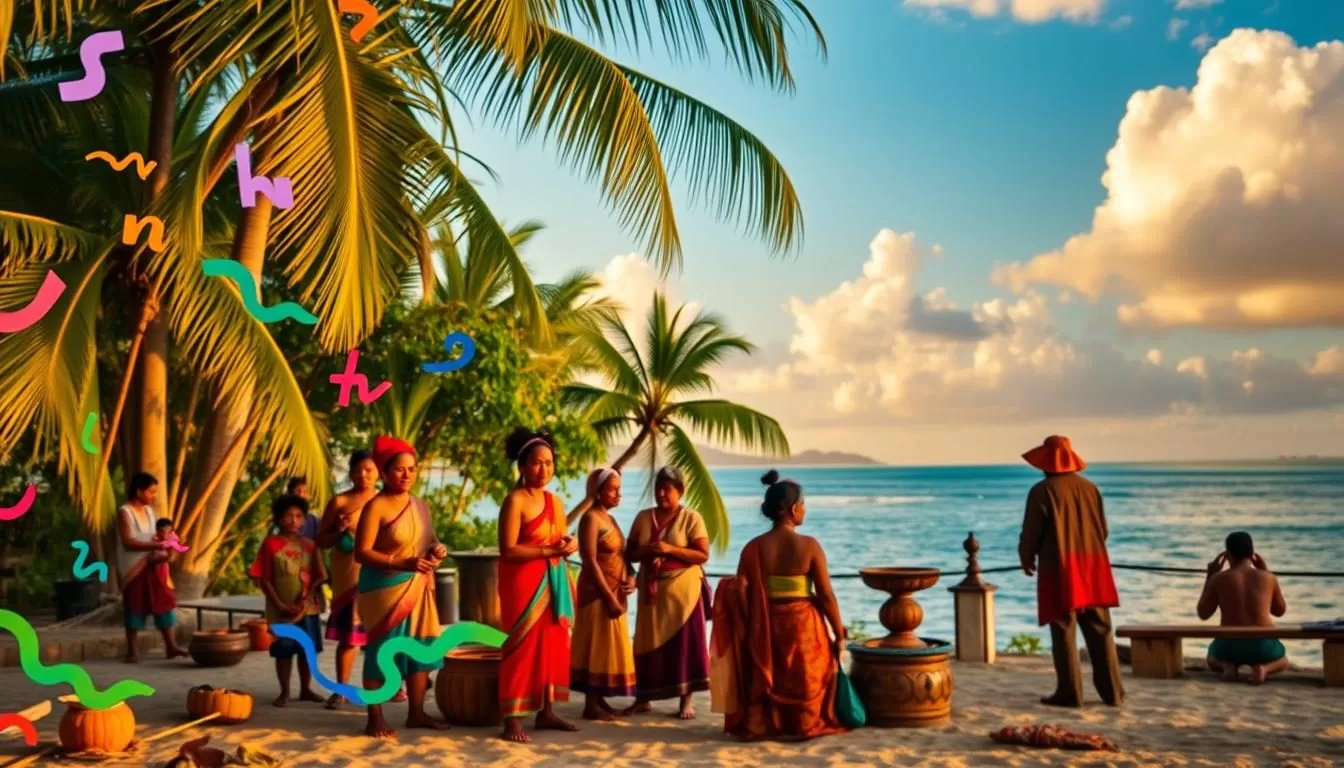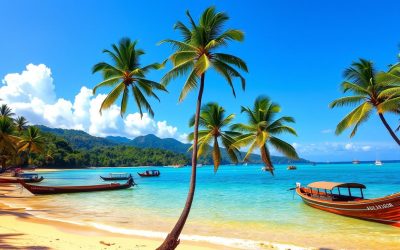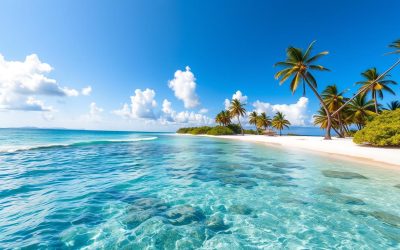✓ Accommodations✓ Flights✓ Rental Cars✓ Tours & Activities
As you explore the Andaman and Nicobar Islands, you’ll discover a fascinating linguistic tapestry where some of the world’s oldest and rarest languages continue to exist alongside modern Indian languages.
The islands serve as a living museum of linguistic diversity, with languages that trace back thousands of years, offering you a unique glimpse into human language evolution.
You’ll encounter a complex mix of official language recognized by the government, indigenous tribal tongues, and languages brought by settlers from mainland India, making the Andaman and Nicobar Islands a true cultural melting pot.
Understanding the linguistic diversity and official language of the islands will enhance your appreciation of the territory’s rich cultural heritage.
The Linguistic Landscape of Andaman and Nicobar Islands
As you explore the Andaman and Nicobar Islands, you’ll discover a unique linguistic landscape shaped by the islands’ geographical and cultural context. This union territory, located in the Bay of Bengal, is an archipelago of over 500 islands, with a population of approximately 400,000 inhabitants.
Geographical and Cultural Context
The Andaman and Nicobar Islands are situated in the Bay of Bengal, comprising more than 500 islands, though only a few dozen are inhabited. The geographical isolation of these islands has created unique linguistic environments where languages have evolved separately from mainland influences for thousands of years. With a population of around 400,000, the islands represent a fascinating cultural mosaic where indigenous tribal communities live alongside settlers from various parts of mainland India.
- The islands’ geographical isolation has contributed to the development of distinct linguistic zones.
- The Andaman group and Nicobar group have different dominant language families and communication patterns.
- Understanding this geographical and cultural context is essential for appreciating the remarkable linguistic diversity.
A Melting Pot of Languages
This union territory serves as a melting pot of languages where ancient tribal tongues coexist with modern Indian languages and administrative languages introduced through colonization and governance. The linguistic diversity reflects the islands’ complex history of indigenous habitation, colonial occupation, post-independence settlement policies, and ongoing migration patterns.
- The islands are home to a culturally mixed population of indigenous tribes and mainland settlers.
- The coexistence of different languages is a result of the islands’ history and migration patterns.
- The linguistic landscape is characterized by a blend of traditional and modern languages.
Historical Influences on Language Development
As you explore the Andaman and Nicobar Islands, you’ll find that their language diversity is deeply rooted in their history. The islands have been home to indigenous groups like the Nicobarese and Great Andamanese for thousands of years, with their languages being relics of the past.
Colonial Impact on Language Evolution
The colonial period, especially the British occupation starting in the late 18th century, introduced English and began the linguistic transformation that continues today. The establishment of the Cellular Jail in Port Blair brought prisoners from various parts of India, introducing mainland languages like Bengali, Tamil, and Telugu to the islands.
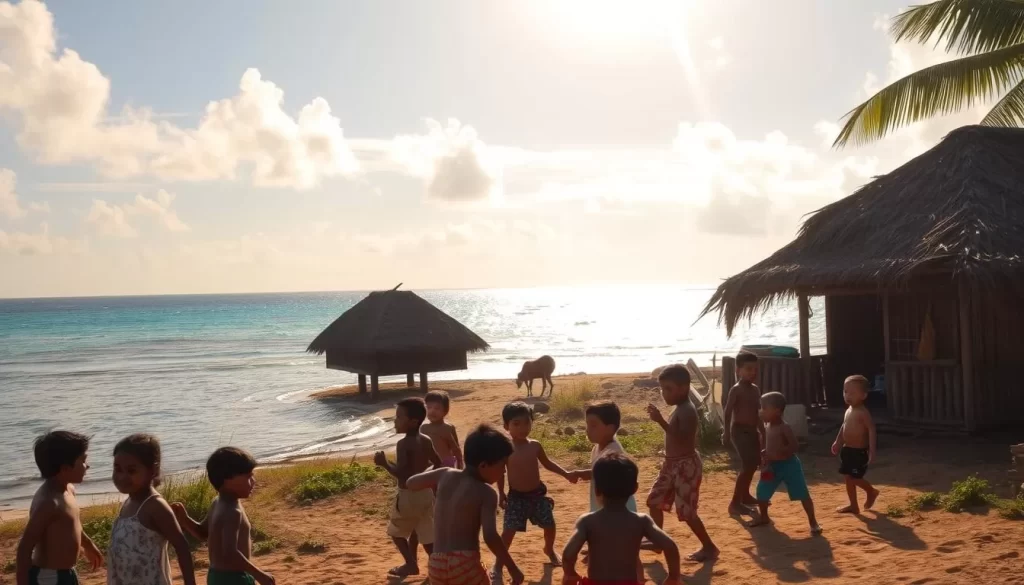
Post-Independence Language Shifts
Following India’s independence in 1947, the Government of India implemented policies that brought Hindi into administrative and educational contexts. Waves of settlement from mainland India dramatically altered the linguistic landscape, with settlers creating new language communities.
The historical influences on the Andaman and Nicobar Islands’ language development can be summarized as follows:
| Period | Event | Impact on Language |
|---|---|---|
| Pre-Colonial | Indigenous groups inhabited the islands | Development of indigenous languages |
| Colonial | British occupation and introduction of English | Linguistic transformation began, changing the state of languages |
| Post-Independence | Government of India policies and settlement from mainland India | Introduction of Hindi and creation of new language communities through their use |
Understanding these historical influences helps you appreciate the complex linguistic profile of the islands today, with ancient tribal languages coexisting alongside official administrative languages.
Andaman and Nicobar Islands (UT), India: Official and Widely Spoken Languages
As you explore the linguistic landscape of the Andaman and Nicobar Islands, you’ll discover the significant roles of Hindi and English. The islands, being a Union Territory of India, have a unique linguistic profile that is shaped by their geographical location and cultural diversity.
Administrative Language
Hindi serves as a primary official language in the Andaman and Nicobar Islands, used extensively in government administration, official documents, and public signage. Approximately 15% of the islands’ population uses Hindi as their mother tongue, making it a significant language both administratively and in everyday communication. The Official Languages Act designates Hindi as an official language throughout India’s territories, including Andaman and Nicobar.
You’ll find that government offices typically function bilingually, with documents and communications available in both Hindi and English to serve the diverse population. This bilingual approach ensures that both local and national administrative needs are met effectively.
| Language | Usage in Administration | Population Using as Mother Tongue |
|---|---|---|
| Hindi | Primary official language, government administration, official documents | 15% |
| English | Secondary official language, higher education, judiciary | Less prevalent, mainly in urban areas |
English in Official Communication
English serves as the second official language in the islands, particularly important for higher education, judiciary, and communication with the central government. You’ll notice that English usage is more prevalent in urban areas like Port Blair and among educated populations, while Hindi dominates in more remote settlements and among government employees.
The islands’ status as a Union Territory means that language policies are directly influenced by the central government rather than by state-level legislation. This influences the use of English in official capacities, especially in higher administration and legal matters.
While Hindi and English hold official status, their actual usage varies significantly across different islands and communities, with practical implementation often accommodating local linguistic realities. This flexibility ensures that the diverse linguistic needs of the population are addressed.
Indigenous Tribal Languages of the Andaman Islands
The Andaman Islands are home to some of the world’s most ancient and isolated language families, offering a glimpse into linguistic traditions that have evolved over tens of thousands of years. You’re about to explore the rich linguistic heritage of these islands, where the original inhabitants have preserved their unique cultural identities through their languages.
Great Andamanese Languages
The Great Andamanese communities, such as the Aka-Jeru, Aka-Bo, and Aka-Kora, once had distinctive languages that were integral to their cultural identities. Unfortunately, the decimation of populations through colonization and diseases resulted in the near annihilation of these languages. Today, only a handful of speakers remain for what is now called Present Great Andamanese.
The Great Andamanese languages once comprised at least 10 distinct languages or dialects, including Aka-Bea, Aka-Jeru, and Aka-Bo. Although most are now extinct, efforts are being made to document and preserve the remaining languages.
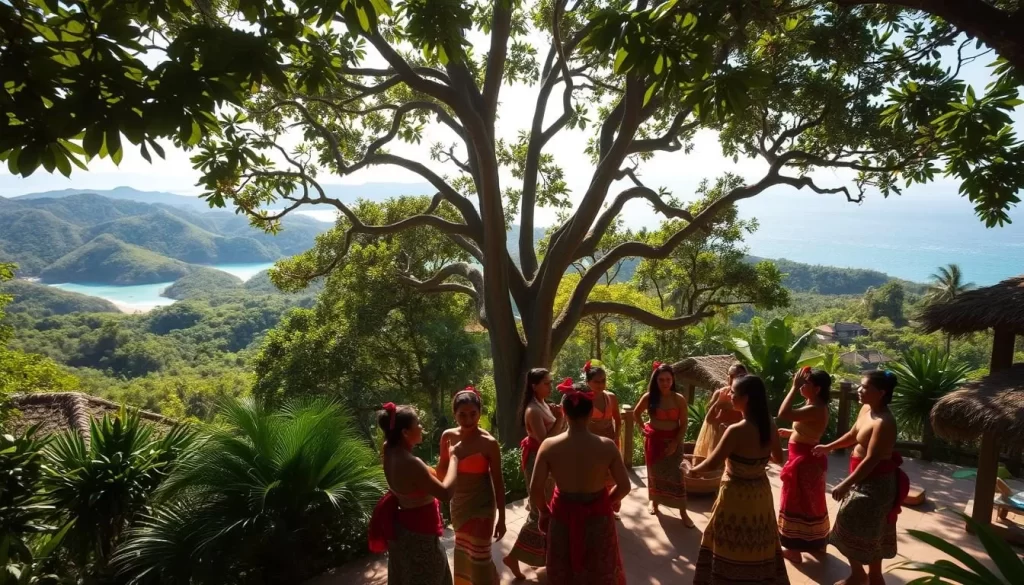
Ongan Languages: Onge and Jarawa
The Onge and Jarawa people have Ongan languages, which are characterized by their unique phonetic and grammatical structures. These languages have been remarkably preserved, despite the challenges posed by external influences. When you study the Ongan language family, you’ll discover the distinctiveness of Önge and Jarawa, two languages that have maintained significant isolation until relatively recently.
The Mysterious Sentinelese Language
The Sentinelese tribe, who live in North Sentinel Island, possess an unknown language that remains one of the world’s most mysterious tongues. Since the tribe has opted to seclude itself, there exists no thorough analysis of the language, and moral grounds prevent intrusive inquiry. The Sentinelese language continues to fascinate linguists and anthropologists, who are eager to understand its structure and significance.
As you reflect on the indigenous tribal languages of the Andaman Islands, you’ll appreciate the unique cultural and linguistic heritage that these languages represent. Each language offers a window into the history, traditions, and worldviews of the tribes that have called these islands home for millennia.
Nicobarese Languages and Dialects
As you explore the Nicobar Islands, you’ll discover a unique linguistic landscape shaped by the Nicobarese language and its dialects. The Nicobarese language is a crucial aspect of the cultural identity of the islands, reflecting the semi-nomadic culture of its people.
The Nicobarese languages belong to the Austroasiatic language family, distinguishing them from the Andamanese languages and indicating different origins and migration patterns for the inhabitants of the two island groups. This classification is significant as it highlights the historical connections between the Nicobar Islands and Southeast Asian cultures.
Car Nicobarese and Its Variants
Car Nicobarese is the most widely spoken of the Nicobarese languages, with approximately 30,000 speakers primarily on Car Nicobar Island and surrounding areas. When exploring the Nicobar Islands, you’ll encounter several distinct dialects of Nicobarese, including Chowra, Teresa, Central Nicobarese, and Southern Nicobarese, each with unique vocabulary and pronunciation patterns.
| Nicobarese Dialects | Speakers | Location |
|---|---|---|
| Car Nicobarese | 30,000 | Car Nicobar Island |
| Chowra | Fewer than 1,000 | Chowra Island |
| Central Nicobarese | Several thousand | Central Nicobar Islands |
Shompen: The Language of Semi-Nomadic Tribes
The Shompen language, spoken by only about 400 people in the interior forests of Great Nicobar Island, represents one of the most endangered languages in the territory. Unlike the more accessible Car Nicobarese speakers, the Shompen tribe maintains a semi-nomadic lifestyle that has limited linguistic documentation and preservation efforts.
The Nicobarese languages have incorporated loanwords from Hindi, Bengali, and English, reflecting increasing contact with mainland Indian culture. Understanding the Nicobarese language family gives you insight into the historical connections between these islands and Southeast Asian cultures.
Mainland Indian Languages in the Islands
As you explore the Andaman and Nicobar Islands, you’ll discover a unique linguistic landscape shaped by mainland Indian languages. The islands’ linguistic diversity is characterized by the presence of various mainland Indian languages, which have been influenced by migration and administration.

Bengali: The Most Widely Spoken Language
Bengali is the most widely spoken language in the Andaman and Nicobar Islands, with approximately 32.6% of the population speaking it as their mother tongue. The significant Bengali presence dates back to the colonial period when freedom fighters and political prisoners were deported to the Cellular Jail, with many settling permanently after their release.
Tamil, Telugu, and Malayalam Speakers
Tamil speakers constitute about 17.8% of the islands’ population, with communities established through both colonial-era migration and post-independence settlement from Tamil Nadu. You’ll also encounter substantial Telugu-speaking communities, particularly in areas developed after independence. Malayalam speakers have established vibrant communities primarily in urban centers and coastal areas, maintaining their linguistic and cultural traditions while adapting to island life.
Other Regional Languages: Punjabi, Gujarati, and Marathi
In addition to the major languages, you’ll find smaller but significant populations of Punjabi, Gujarati, and Marathi speakers, many of whom came to the islands as government employees, business people, or as part of settlement programs. These communities have maintained their languages and cultural traditions, contributing to the islands’ linguistic diversity.
The Role of Migration in Language Distribution
The distribution of mainland Indian languages in the Andaman and Nicobar Islands follows distinct patterns related to historical migration waves, government settlement policies, and economic opportunities. Understanding this linguistic mosaic helps you appreciate how the islands serve as a microcosm of India’s broader linguistic diversity, with communities maintaining their languages while participating in a shared island identity.
- The continued use of these mainland languages is supported through community organizations, cultural associations, and in some cases, language-specific educational programs.
- The linguistic diversity of the Andaman and Nicobar Islands is a reflection of the complex history of migration and settlement in the region.
Language Education and Policy in the Islands
As you delve into the language education system and policies of the Andaman and Nicobar Islands, you’ll discover a complex interplay of official and indigenous languages. The region’s linguistic diversity is influenced by its history, cultural identity, and the policies implemented by the government.
School Education and Medium of Instruction
The medium of instruction in government schools is primarily Hindi or English, catering to the broader population. However, some schools offer education in Bengali, Tamil, or Telugu to serve specific community needs. You’ll find that language education in the Andaman and Nicobar Islands follows a complex three-language formula, with Hindi and English typically serving as two of the languages and a regional language as the third.
Government Initiatives for Language Preservation
The government has launched various initiatives aimed at preserving the linguistic diversity of the islands. These include specialized programs for documenting and teaching indigenous languages, as well as tribal welfare policies that incorporate mother-tongue education for more integrated tribal communities. The implementation of the Official Languages Act creates a framework where Hindi and English dominate administrative and educational contexts, sometimes at the expense of local languages.
Educational institutions like Jawaharlal Nehru Rajkeeya Mahavidyalaya (JNRM) and other colleges offer language courses that reflect both official priorities and local linguistic diversity, providing a balanced approach to language education.
Endangered Languages and Conservation Efforts
As you explore the linguistic landscape of the Andaman and Nicobar Islands, you’ll find that many indigenous languages are threatened by modernization and assimilation. The loss of these languages is not just a linguistic issue; it represents a significant threat to the cultural identities associated with them. When younger generations adopt mainstream languages such as Hindi and English, native languages go out of use, leading to a loss of cultural heritage.
Critically Endangered Tribal Languages
Several indigenous languages of the Andaman and Nicobar Islands are classified as critically endangered by UNESCO, with some having fewer than 10 remaining speakers. The Great Andamanese languages have experienced the most severe decline, with ten distinct languages reduced to a single mixed language with fewer than 50 speakers today. This drastic reduction highlights the urgent need for conservation efforts to preserve these languages.
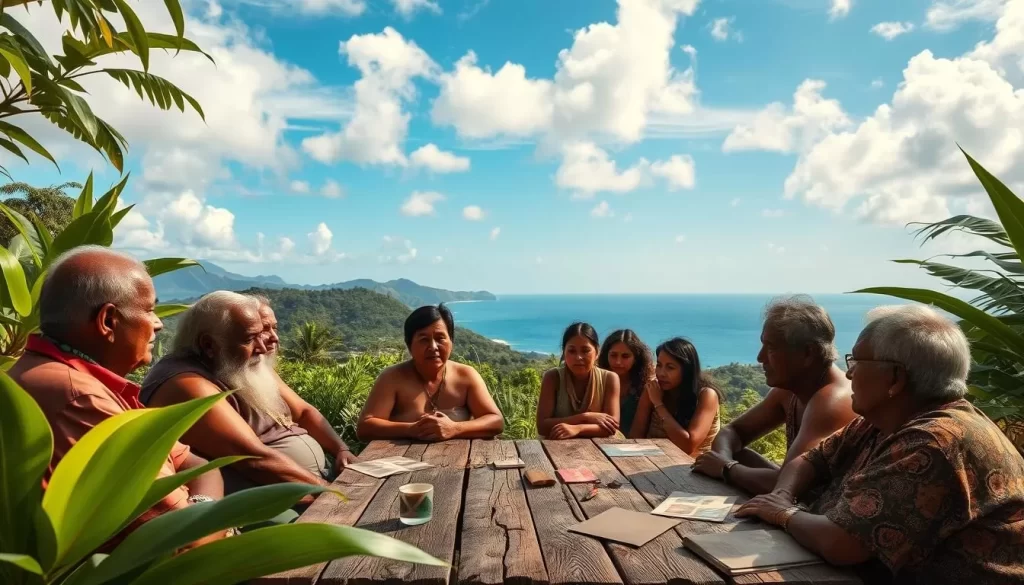
Documentation and Revitalization Projects
Linguists and anthropologists have worked hard to document these languages, creating dictionaries and recording oral traditions in an attempt to preserve them. Organizations like the Anthropological Survey of India and academic institutions have undertaken documentation projects to record vocabulary, grammar, and oral traditions before they disappear. Community-based revitalization initiatives aim to teach younger generations their ancestral languages through specialized programs and cultural immersion activities. Government-sponsored steps taken include the establishment of tribal language centers and the development of educational materials in indigenous languages.
These conservation efforts are crucial in maintaining the linguistic diversity of the Andaman and Nicobar Islands. By understanding the challenges faced by these languages and the steps being taken to preserve them, you gain insight into the global challenge of maintaining linguistic diversity in the face of homogenizing forces.
Cultural Identity Through Language
The languages used in the Andaman and Nicobar Islands are not just means of communication but also carriers of cultural identity. You see this in how language serves as a fundamental marker of tribal identity, with distinct vocabularies and speech patterns defining community boundaries and social relationships.
Language as a Marker of Tribal Identity
For indigenous communities, their native language embodies traditional knowledge systems, including detailed understanding of local ecosystems and spiritual practices. When you examine tribal languages, you’ll find they contain unique concepts reflecting worldviews developed over thousands of years.
Linguistic Diversity and Cultural Heritage
The linguistic diversity of the islands represents an invaluable cultural heritage, providing insights into human cognitive development. Even as younger generations adopt mainstream languages, certain cultural expressions continue in traditional language
Understanding the relationship between language and cultural identity highlights the importance of language preservation efforts, which are about protecting entire ways of being and knowing.
Conclusion
The unique blend of languages in the Andaman and Nicobar Islands offers a fascinating glimpse into the region’s history and cultural identity. As you’ve explored throughout this guide, the islands represent a remarkable linguistic treasure trove where ancient tribal languages coexist with official languages and those brought by settlers from mainland India.
The Andaman and Nicobar Islands are home to a diverse population that speaks various languages, including Hindi and English as official languages, while Bengali, Tamil, and other mainland languages serve large community populations. However, the precarious state of indigenous tribal languages highlights the need for balanced language policies that promote national integration while preserving cultural heritage.
As you consider the future of languages in the islands, it’s clear that the government’s approach to language policy will shape linguistic patterns, impacting education, administration, and cultural identity. By celebrating this heritage and promoting the preservation of these languages, we can ensure the rich cultural diversity of the Andaman and Nicobar Islands is maintained for future generations.
The above is subject to change.
Check back often to TRAVEL.COM for the latest travel tips and deals.
